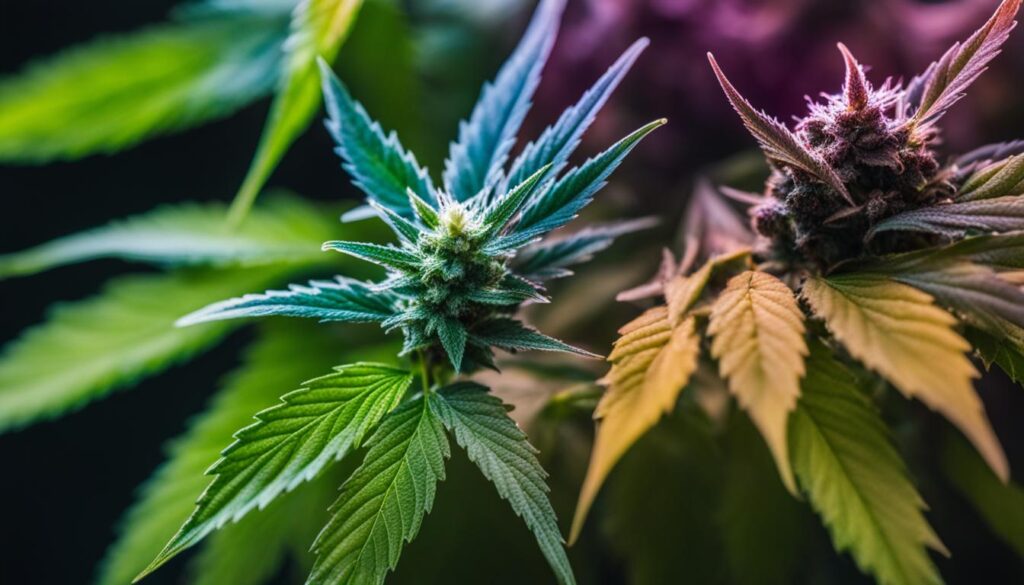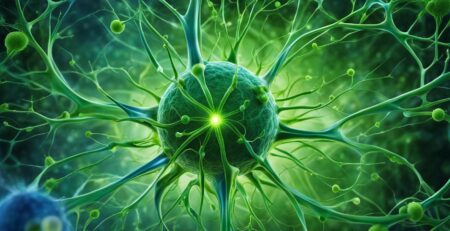Exploring the Entourage Effect: Does CBD Require THC?
Welcome to our exploration of the entourage effect and its significance in the world of CBD. As CBD continues to gain popularity for its potential health benefits, many are curious about the role of THC, another compound found in cannabis.
The entourage effect suggests that the combination of various compounds, including cannabinoids like THC and CBD, terpenes, and flavonoids, work synergistically to enhance the therapeutic effects of cannabis. While CBD can provide its own health benefits, the presence of THC is believed to amplify the overall effectiveness of CBD, leading to the inclusion of THC in some CBD products.
By understanding the entourage effect, we can gain a deeper appreciation for the potential benefits of combining different compounds in CBD products. Join us as we delve into the intricate interactions within cannabis and explore the future possibilities of holistic healing.
Key Takeaways:
- The entourage effect suggests that CBD and THC, along with other compounds, work together to enhance the therapeutic benefits of cannabis.
- THC is believed to amplify the overall effectiveness of CBD, leading to the inclusion of THC in some CBD products.
- Understanding the entourage effect can help individuals make informed choices when it comes to selecting CBD products.
- Combining different compounds in CBD products may offer a more comprehensive approach to holistic healing.
- Ongoing research is crucial for uncovering the full potential of the entourage effect and its applications in various health conditions.
Terpenes: The Aroma Architects of Cannabis
Terpenes are the unsung heroes of the cannabis plant, responsible for its captivating scents and flavors. These aromatic compounds can also have a significant impact on the overall cannabis experience, influencing the effects and therapeutic benefits of different strains.
With over 100 terpenes identified in cannabis, each strain possesses a unique terpene profile that sets it apart. Some common terpenes found in cannabis include myrcene, limonene, linalool, caryophyllene, and pinene. These terpenes not only contribute to the aroma and taste but also influence the way the plant interacts with our bodies.
Understanding terpene profiles is crucial for individuals seeking to tailor their cannabis experience to their desired effects, flavors, and aromas. Whether you're looking for relaxation, energy, or pain relief, selecting strains with specific terpenes can help you achieve your desired outcome.
| Terpene | Aroma | Potential Effects |
|---|---|---|
| Myrcene | Earthy, musky, herbal | Relaxation, sedation, relief from pain and inflammation |
| Limonene | Citrusy, lemon-like | Elevated mood, stress relief, improved focus |
| Linalool | Floral, lavender-like | Calming, anti-anxiety, sleep aid |
| Caryophyllene | Spicy, peppery | Pain relief, anti-inflammatory, potential anti-cancer properties |
| Pinene | Piney, woody | Enhanced alertness, focus, respiratory benefits |
By exploring terpenes, cannabis enthusiasts can better understand the complexities of the plant and tailor their consumption to their preferences. Whether you crave the earthy tones of myrcene or the uplifting citrus notes of limonene, terpenes play a vital role in shaping your cannabis experience.
“Terpenes are like the aromatic architects of cannabis, shaping the flavors and effects of different strains.”
The Role of THC and CBD in the Entourage Effect
When it comes to the entourage effect, the interaction between THC and CBD is of great significance. THC (tetrahydrocannabinol) and CBD (cannabidiol) are two well-known cannabinoids found in cannabis, and they each play a unique role in enhancing the therapeutic potential of the plant.
While CBD is praised for its non-psychoactive nature and potential health benefits, the presence of THC is believed to amplify the effects of CBD. This synergy between THC and CBD is what creates the entourage effect, where the combined therapeutic properties of these cannabinoids and other compounds found in cannabis work together to provide enhanced health benefits.
“The entourage effect suggests that the combination of THC and CBD can have a synergistic effect, enhancing the overall therapeutic potential of cannabis.”
It is important to note that while CBD has gained popularity for its standalone benefits, the entourage effect suggests that CBD without THC may not offer the same level of effectiveness. Research has shown that the presence of THC can enhance the anti-inflammatory, analgesic, and neuroprotective properties of CBD, making it more potent in a therapeutic context.
As the field of cannabis research continues to expand, scientists are delving deeper into understanding the intricate interactions between THC and CBD, along with other cannabinoids, terpenes, and flavonoids found in cannabis. This ongoing exploration seeks to uncover the full potential of the entourage effect and its implications for developing more effective cannabis-based treatments.
The Synergy of THC and CBD in the Entourage Effect
The entourage effect demonstrates that the therapeutic benefits of cannabis are not solely attributed to isolated compounds like THC or CBD but rather the combined action of multiple components present in the plant. THC and CBD, in particular, have been found to work synergistically, enhancing each other's effects and offering a more comprehensive range of therapeutic benefits.
The Significance of Terpenes in the Entourage Effect
Terpenes, the aromatic compounds found in cannabis, play a vital role in the entourage effect, contributing to the overall therapeutic profile of the plant. Not only do terpenes give each cannabis strain its distinct aroma and flavor, but they also have potential therapeutic properties of their own. Recent studies have shown that terpenes such as myrcene, limonene, linalool, caryophyllene, and pinene may offer various health benefits, including relaxation, anxiety reduction, and anti-inflammatory effects.
In addition to their independent effects, terpenes interact with other cannabis compounds, such as cannabinoids and flavonoids, to create a synergistic effect. These interactions can enhance the therapeutic potential of cannabis by modulating the effects of cannabinoids like THC and CBD. For example, myrcene, a terpene commonly found in cannabis, may increase the permeability of cell membranes, allowing for greater absorption of cannabinoids. This means that the presence of specific terpenes can influence how cannabinoids are absorbed, metabolized, and ultimately, how they affect the body.
To better understand the significance of terpenes in the entourage effect, consider the following table:
| Terpene | Commonly Found In | Potential Benefits |
|---|---|---|
| Myrcene | Hops, Mangoes | Promotes relaxation, anti-inflammatory effects |
| Limonene | Citrus fruits | Reduces stress, elevates mood, anti-cancer properties |
| Linalool | Lavender, mint | Calming effects, anxiety reduction, sleep aid |
| Caryophyllene | Black pepper, cloves | Anti-inflammatory effects, pain relief |
| Pinene | Pine needles, rosemary | Increases alertness, promotes focus, anti-inflammatory properties |
It's important to note that terpenes are not exclusive to cannabis and can be found in various other plants as well. Their diverse range of aromas and potential health benefits make them a crucial component of the entourage effect.

Unlocking the Therapeutic Potential of Terpenes
As research into cannabis continues to evolve, scientists are exploring the therapeutic potential of terpenes in greater detail. By understanding the specific terpene profiles of different cannabis strains, individuals can select strains that align with their desired effects and therapeutic goals. For example, those seeking relaxation and anxiety relief may opt for strains high in myrcene, while individuals looking for mood elevation and stress reduction may prefer strains rich in limonene or linalool.
The entourage effect highlights the importance of considering all the compounds present in cannabis when utilizing it for medicinal purposes. By focusing on terpenes, cannabinoids, and flavonoids together, individuals can potentially experience enhanced therapeutic effects and a more comprehensive approach to holistic healing.
Whole Plant Medicine and the Entourage Effect
Whole plant medicine is a holistic approach to utilizing the therapeutic potential of cannabis. It involves using the plant in its natural form, incorporating all of the compounds found within it, including cannabinoids, terpenes, and flavonoids, in their natural ratios. By embracing whole plant medicine, individuals can fully harness the power of the entourage effect, which suggests that these compounds work together synergistically to enhance the overall therapeutic benefits of cannabis.
When cannabinoids, terpenes, and flavonoids are consumed together, they can provide a more comprehensive range of therapeutic effects. Research has shown that these compounds have different mechanisms of action and can target various pathways in the body, resulting in potentially enhanced therapeutic outcomes. By utilizing whole plant medicine, individuals may be able to experience the collective benefits of these compounds, including reduced inflammation, pain relief, relaxation, and more.
“Whole plant medicine maximizes the therapeutic potential of cannabis and may have fewer side effects compared to using isolated compounds.”
The Benefits of Whole Plant Medicine
One of the key advantages of whole plant medicine is the potential for reduced side effects compared to using isolated compounds. When cannabinoids, terpenes, and flavonoids are consumed together, they can modulate each other's effects, potentially minimizing any unwanted side effects. Additionally, the presence of multiple compounds may help to counteract the psychoactive effects of THC, making cannabis more accessible to individuals who may be sensitive to its intoxicating properties.
Furthermore, whole plant medicine allows for a more comprehensive and holistic approach to treating health conditions. Different compounds within cannabis have been found to have unique therapeutic benefits, and by using the whole plant, individuals can benefit from the full spectrum of these properties. This can be particularly valuable in disorders that require a multifaceted approach, such as chronic pain or neurological conditions.
Exploring the Therapeutic Potential
While there is still much to learn about the intricate interactions within cannabis, the concept of whole plant medicine and the entourage effect provide a promising foundation for further exploration. Researchers are actively studying the different compounds found in cannabis and their potential therapeutic applications. By gaining a deeper understanding of how these compounds interact and amplify each other's effects, scientists hope to unlock new treatment possibilities and expand our knowledge of the therapeutic potential of cannabis.
| Compound | Therapeutic Potential |
|---|---|
| Cannabinoids | Pain relief, anti-inflammatory properties, neuroprotective effects |
| Terpenes | Relaxation, anti-anxiety effects, antioxidant properties |
| Flavonoids | Anti-inflammatory effects, potential anticancer properties, neuroprotective effects |
“Whole plant medicine and the entourage effect open up new possibilities for harnessing the therapeutic benefits of cannabis in a more comprehensive and effective manner.”
In conclusion, whole plant medicine, in conjunction with the entourage effect, offers a promising approach to utilizing the therapeutic potential of cannabis. By consuming cannabis in its natural form and incorporating all of its compounds, individuals can potentially experience enhanced therapeutic benefits and reduced side effects. As research continues to uncover the intricacies of cannabis's compounds and their interactions, the future holds exciting possibilities for leveraging the holistic healing properties of this versatile plant.
The Intricate Interactions within Cannabis
As scientists and healthcare professionals delve deeper into the study of cannabis, they are uncovering a world of intricate interactions within the plant. This research aims to understand the complex relationships between cannabinoids, terpenes, and other compounds found in cannabis, and how these interactions contribute to its medicinal use and holistic healing potential.
The entourage effect, a concept that highlights the synergistic effects of various cannabis compounds, plays a significant role in these interactions. It suggests that the combination of cannabinoids like THC and CBD, along with terpenes and flavonoids, can enhance the overall therapeutic benefits of cannabis. By examining these interactions, researchers hope to develop a more comprehensive understanding of cannabis and its potential applications in medicine.
Cannabis research is paving the way for the future of medicinal use. By studying the composition and interactions of cannabis compounds, researchers can identify specific combinations that may have targeted effects for different health conditions. This knowledge can lead to the development of more tailored treatments, reducing the reliance on one-size-fits-all approaches and potentially improving patient outcomes.
The holistic healing potential of cannabis is being explored through various studies and clinical trials. By taking a whole plant medicine approach, which incorporates all the compounds found in cannabis, researchers hope to harness the synergistic effects of these compounds for maximum therapeutic benefits. This approach may offer a more comprehensive and effective solution for treating a wide range of health issues.
Cannabis Interactions: Unlocking the Future of Medicine
From the entourage effect to the discovery of new therapeutic compounds, cannabis research is unlocking a promising future for medicine. By understanding the intricate interactions within cannabis, scientists and healthcare professionals can tap into its holistic healing potential and develop innovative treatments that target specific health conditions. Continued exploration and advancement in cannabis research will undoubtedly lead to new discoveries and expand our understanding of this versatile plant.

The Future of Medicinal Cannabis and the Entourage Effect
The entourage effect of cannabis has significant implications for medicinal cannabis and its therapeutic benefits. By understanding the holistic power of cannabis compounds and conducting cannabinoid research, researchers and healthcare professionals can potentially develop more effective treatments for various health conditions.
The entourage effect suggests that the combination of different compounds in cannabis, such as cannabinoids, terpenes, and flavonoids, work synergistically to enhance the overall therapeutic potential of the plant. This means that the whole plant, with all its natural ratios of compounds, may have greater healing properties compared to using isolated compounds alone.
Through ongoing research, scientists aim to unlock the full potential of medicinal cannabis and explore how different compounds interact with each other. This research can pave the way for the development of new treatments that harness the holistic power of cannabis and provide improved therapeutic benefits for patients.
To illustrate the intricate interactions within cannabis, the following table showcases some of the key compounds found in the plant:
| Compound | Properties |
|---|---|
| Cannabinoids | May have analgesic, anti-inflammatory, and neuroprotective effects |
| Terpenes | Contribute to the aroma and flavor of cannabis, and may have various therapeutic properties |
| Flavonoids | Antioxidant, anti-inflammatory, and neuroprotective properties |
By exploring the complex interactions between these compounds, researchers can better understand the potential of medicinal cannabis and continue to expand our knowledge of its holistic healing properties. This ongoing research holds promise for the future of cannabinoid-based therapies and the development of more effective treatments.
Exploring CBD Oil for Pain Relief
CBD oil has gained significant attention for its potential benefits in managing various types of pain, including neuropathic pain, arthritis pain, chronic pain, and inflammation-associated pain. Scientific studies, both on animals and humans, have shown promising results in reducing pain and inflammation. CBD, or cannabidiol, is a non-intoxicating cannabinoid derived from the cannabis plant that is known for its potential therapeutic properties.
Neuropathic pain, which is caused by damage or dysfunction of the nervous system, can be particularly challenging to manage. However, research suggests that CBD oil may offer relief for neuropathic pain by interacting with the body's endocannabinoid system, which plays a role in pain regulation. Studies have shown that CBD can help reduce neuropathic pain and improve overall quality of life for individuals suffering from this condition.
Arthritis, a common condition characterized by joint inflammation, can also cause significant pain and discomfort. CBD oil has been studied for its potential anti-inflammatory properties and its ability to relieve arthritis pain. Research has shown that CBD can help reduce inflammation in the joints and alleviate pain associated with arthritis, providing a natural alternative for individuals seeking relief.
Chronic pain, which persists for an extended period, can have a significant impact on an individual's daily life. CBD oil has been found to have analgesic properties, meaning it can help reduce pain sensations. By interacting with the endocannabinoid system, CBD may modulate pain signals and provide relief for individuals living with chronic pain conditions.
While CBD oil shows promise as a natural pain relief option, it is essential to consult with a healthcare professional before incorporating it into a pain management plan. They can provide guidance on dosage, potential interactions with other medications, and help determine if CBD oil is a suitable option for individual needs.
References:
- “Cannabidiol in Medical Marijuana: Research Vistas and Potential Opportunities,” Neurotherapeutics, 2015.
- “Cannabinoids in the Management of Difficult to Treat Pain,” Therapeutics and Clinical Risk Management, 2008.
- “Cannabidiol: Promise and Pitfalls,” Epilepsy Currents, 2014.
Table: CBD Oil for Pain Relief Studies
| Study | Pain Condition | Results |
|---|---|---|
| “Cannabidiol in Medical Marijuana: Research Vistas and Potential Opportunities” | Neuropathic pain | Promising results in reducing neuropathic pain and improving quality of life |
| “Cannabinoids in the Management of Difficult to Treat Pain” | Arthritis pain | Reduction in inflammation and relief of arthritis pain |
| “Cannabidiol: Promise and Pitfalls” | Chronic pain | Analgesic properties and modulation of pain signals |
Conclusion
In conclusion, the entourage effect and the role of CBD and THC in cannabis highlight the potential benefits of combining different compounds for holistic healing. While CBD oil alone can provide therapeutic effects, the entourage effect suggests that the presence of THC and other compounds in cannabis may enhance the overall effectiveness of CBD in pain relief and other health concerns.
Research into the intricate interactions within cannabis and the potential of whole plant medicine holds promise for the future of cannabis research. Understanding the entourage effect and utilizing the synergistic power of diverse compounds may lead to the development of more effective treatments for various health conditions, expanding our understanding and application of medicinal cannabis.
As we continue to explore the entourage effect and the benefits it offers, the future of cannabis research looks promising. With ongoing studies and discoveries in cannabinoid interactions, we can unlock new therapeutic benefits and further harness the holistic healing potential of cannabis. CBD oil for pain relief is just one example of the possibilities that lie ahead in our exploration of the entourage effect and its impact on overall health and wellness.
FAQ
What is the entourage effect?
The entourage effect refers to the synergistic interaction between the various compounds found in cannabis, including cannabinoids like THC and CBD, terpenes, and flavonoids. It suggests that these compounds work together to enhance the therapeutic benefits of cannabis.
Does CBD require THC to be effective?
CBD can provide health benefits on its own, but the presence of THC is believed to enhance the overall effectiveness of CBD. This has led to the inclusion of THC in some CBD products, as it may amplify the potential benefits of CBD.
What are terpenes?
Terpenes are aromatic compounds found in cannabis and other plants. They contribute to the distinct scents and flavors of different cannabis strains and can also influence the effects of cannabis consumption.
How do terpenes contribute to the cannabis experience?
Understanding the dominant terpenes in different cannabis strains can help individuals tailor their cannabis experience to their desired effects, flavors, and aromas.
What is the role of THC and CBD in the entourage effect?
While CBD does not produce psychoactive effects like THC, the presence of THC is believed to enhance the potential benefits of CBD. CBD without THC may still provide health benefits, but the entourage effect suggests that the combination of THC and CBD can have a synergistic effect.
Why are terpenes significant in the entourage effect?
Terpenes play a crucial role in the entourage effect, contributing to the overall therapeutic profile of cannabis. They are not only responsible for the aroma and flavor of different cannabis strains but also have potential therapeutic properties of their own.
What is whole plant medicine?
Whole plant medicine refers to the use of cannabis in its natural form, incorporating all the compounds found in the plant, including cannabinoids, terpenes, and flavonoids, in their natural ratios. This approach maximizes the therapeutic potential of cannabis and may have fewer side effects compared to using isolated compounds.
What are the implications of the entourage effect for medicinal cannabis?
By harnessing the synergistic power of the diverse compounds in cannabis, researchers and healthcare professionals can potentially develop more effective treatments for various health conditions. Ongoing research into cannabinoid interactions and the holistic healing potential of cannabis holds promise for unlocking new therapeutic benefits and expanding our understanding of this versatile plant.
Can CBD oil help with pain relief?
CBD oil has gained attention for its potential benefits in managing various types of pain, including neuropathic pain, arthritis pain, chronic pain, and inflammation-associated pain. Scientific studies have shown promising results in reducing pain and inflammation, but it is important to consult with a healthcare professional before incorporating CBD oil into a pain management plan.
Source Links
- https://pharmeasy.in/blog/cbd-oil-for-pain-a-comprehensive-review-on-its-effectiveness/
- https://www.linkedin.com/posts/arshad-shafi-b705275_welcome-activity-7130494454779502592-9lWW
- https://www.allthebuzzdc.com/post/unraveling-the-mystery-the-role-of-terpenes-in-your-cannabis-experience











Leave a Reply